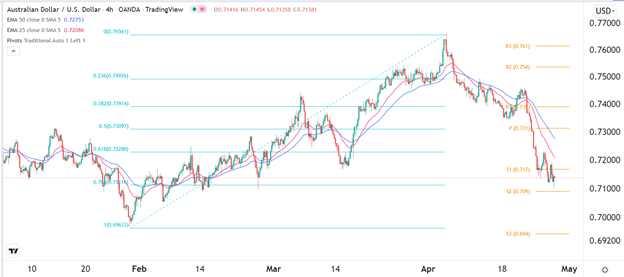Bearish View
- Set a sell-stop at 0.7110 and a take-profit at 0.7000.
- Add a stop-loss at 0.7225.
- Timeline: 2 days.
Bullish View
- Set a buy-stop at 0.7170 and a take-profit at 0.7250.
- Add a stop-loss at 0.7100.
The AUD/USD pair crashed to the lowest level since February 22nd even after the strong Australian inflation data. The Australian dollar retreated to the important support at 0.7100 as data showed that consumer prices are still surging.
Aggressive RBA?
Data published by the Australian Bureau of Statistics showed that inflation rose at a faster pace than expected. The headline CPI rose from 3.5% in the fourth quarter to 2.1% in Q1. That increase was significantly higher than the median estimate of 1.7%.
As a result, the numbers revealed that the CPI rose from 3.5% to 5.1%, which was the highest level in 21 years. Economists poll by Reuters were expecting the number to show that inflation rose by 4.6%. Meanwhile, the trimmed and weighted mean CPIs rose by 3.7% and 3.2%, respectively.
These numbers were higher than the Reserve Bank of Australia (RBA) target of 2.0%. Therefore, analysts expect that the RBA will start talking about rate hikes when it meets next week. Some expect that the bank will actually deliver a gentle 15 basis point rate hike since they believe that it has underestimated the strength of inflation. In the United States, the Fed has been blamed for underestimating inflation last year.
The AUD/USD pair declined after the report because of the stubbornness of the US dollar. The dollar index has been relatively strong as investors focus on the rising global risks. For example, Russia decided to halt natural gas shipments to Poland and Bulgaria. It has insisted that these countries should pay for their gas in rubles. Therefore, there is a likelihood that it will also cut shipments to the rest of Europe soon.
The key catalyst for the AUD/USD pair will be the latest US GDP and initial jobless claims numbers. The consensus is that the American economy expanded by 7.3% in Q1.
AUD/USD Forecast
The AUD/USD continued its bearish trend after the strong Australian inflation data. The decline happened partly because investors were expecting inflation to be strong. It also moved below the 25-day and 50-day moving averages and the 61.8% Fibonacci retracement level. It has also moved below the first standard of the pivot point.
Therefore, the pair will likely keep falling as the US dollar strength continues. If this happens, the next key support level to watch will be the psychological level at 0.7000.

